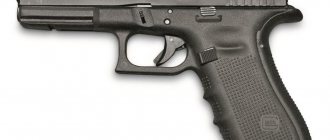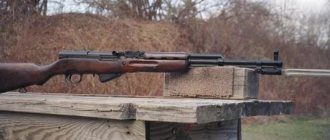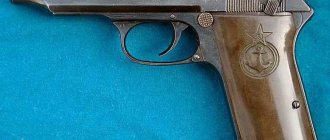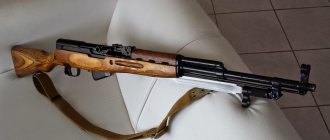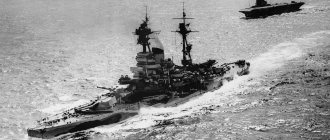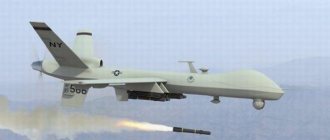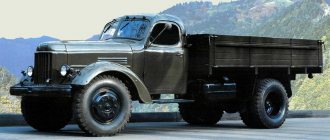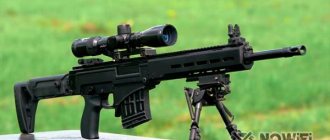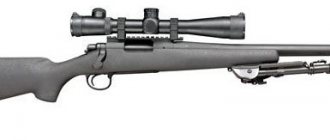Superiority in the skies is one of the key aspects of modern military operations. Control over airspace allows you to strike at enemy positions, disabling not only key objects, but also armored vehicles. It is for these purposes that attack aircraft are developed.
This type of combat aircraft is designed to solve a variety of tasks - from conducting air combat to destroying ground targets. The main emphasis is on supporting land and sea forces in combat in both large-scale and local conflicts.
Su-39 (Su-39) is a promising Russian development by the Sukhoi Design Bureau, based on the Su-25T. Designed to defeat armored vehicles and conduct combat in any weather conditions. Despite the successful creation of prototypes, these aircraft never entered service with Russia.
History of creation
Su-39 in the sky
The development of the “thunderer” Su 39 is closely related to the work on modernizing the Su-25. This attack aircraft was designed in the mid-1970s and began to be actively used in 1981. The aircraft underwent combat tests in Afghanistan and showed the demand for attack aircraft in local conflicts.
Gradually, the attack aircraft was modernized and additional requirements were imposed on new developments. Among them are the ability to conduct operations at any time of the day, installation of modern avionics and weapons capable of hitting enemy armored vehicles.
In the context of these requirements, a modification of the Su-25T appeared, aimed at countering attack tanks. Later, on its basis, a modernized version of the Su-25TM was developed, which received the designation Su-39. Work on this modernization began in 1986, the first flights of prototypes took place in 1991.
Initially, the production of new attack aircraft was planned to be established at an aircraft plant in Tbilisi. However, the collapse of the USSR did not allow the implementation of this project. Production was moved to Ulan-Ude. The first pre-production Su-25TM flew in 1995. At the same time it was given the designation Su-39.
Lack of funding did not allow the production of new attack aircraft to begin. A project was being developed to modernize the Su-25T into new aircraft, but it also required significant funds. Soon all aircraft of this type were written off. As a result, the Su-39 “flying tank” remained an unrealized project, for which only 4 experimental aircraft were assembled.
Description of design
Drawing of the Su-39 with weapons and additional fuel tanks
The general design of the Su-39 is similar to the Su-25UB combat trainer aircraft. The key difference is that the co-pilot's seat is occupied by an additional fuel tank and electronic equipment. Taking into account the location of additional avionics, the double-barreled gun mount is shifted 273 mm to the right. The front landing gear is shifted to the left by 222 mm.
Fuselage
The forward part of the fuselage received an elongated and expanded shape to accommodate the Shkval system. The shape of the nose cone of the laser target designation system is also different. The middle part of the fuselage follows the design of the Su-25UB; an additional fuel tank is located in the tail.
Booking
The armor of the attack aircraft is borrowed from the original Su-25. The pilot is seated in an all-welded cockpit made of aircraft-grade titanium armor. Its thickness has the following indicators:
- sides - 24 mm;
- rear wall and bottom - 10 mm;
- frontal wall - 24 mm;
- frontal armor block - 57 mm.
In some cases, the armored cockpit can withstand 30 mm shell hits. This ensures high crew survivability.
Plumage
One of the significant differences between the new attack aircraft and the base model is the appearance of horizontal tail boosters in the longitudinal channel. The wing of the new attack aircraft is unified with the Su-25UB, but the brake flap containers received antennas of the Irtysh system.
Power point
The Su-39 is equipped with two R-195 turbojet engines. Compared to the power plant of the original Su-25, the endurance and thrust in emergency mode have been increased, fuel consumption and infrared radiation have been reduced. The engine performance characteristics have the following indicators:
- fuel - kerosene, gasoline, diesel;
- engine length - 7.88 m;
- diameter - 0.805 m;
- base weight - 574 kg.
Fuel consumption was 0.89 kg/kgf per hour. If necessary, the engine was interchangeable with the R-95Sh.
Cockpit
The pilot's cabin was sealed and housed in an armored capsule. Excess pressure is 0.25 kg per square centimeter, which made it possible to raise the altitude threshold to 10 thousand m. The pressure is maintained automatically by the control unit and the exhaust valve. The cockpit canopy consists of a fixed canopy with a transparent armored block and a folding part with an armored headrest.
Airplane stabilizer
The stabilizer of the attack aircraft is designed for three positions - flight, maneuvering and takeoff and landing. Switching is done by a hydraulic cylinder.
Chassis and racks
The Su-39 has a three-legged chassis, the struts are unified with the Su-25 and Su-25UB. There are KT-163D brake wheels. In flight, the landing gear is retracted, the niches are closed with flaps with kinematic drives. The supports are released and retracted using two hydraulic systems.
Electronic equipment
Su-25UB - it was its design that formed the basis of the Su-39
The electronic equipment of the Su-39 attack aircraft is represented by the Spear-25 radar system, which has the following characteristics:
- slot antenna, diameter - 0.5 m;
- scanning angle in height - +25°/-55°, in azimuth - ±40°;
- viewing areas - ±10°/±20°/±40°;
- number of simultaneously tracked targets - 8;
- number of simultaneously attacked targets - 2.
The detection range of air targets with an effective dispersion area (ESR) of five square meters in free space is 57 km in oncoming traffic and 30 km in pursuit. The second indicator against the background of the earth is reduced to 20 km.
Detection of ground targets depends on their type. The Su-39 is capable of identifying a destroyer within a range of 200 km, and stationary objects such as a railway bridge - 100 km. A group of tanks is fixed within 20 km.
The guidance of anti-tank guided missiles was adjusted by the Kinzhal radar system. The aircraft also had the Irtysh anti-aircraft defense system, which included:
- exposure detection and identification system;
- station for creating active radio interference "Gardenia";
- container with infrared traps and dipole reflectors;
- Generator of active infrared interference "Dry Cargo";
- route selection system for maintaining radar stealth "Omul".
All used systems are combined into a common sighting and navigation complex “Orbita-20”. It allows you to recognize and track small ground targets with automatic target designation for all aircraft weapons. This system also includes the Shkval sighting system.
Sighting system "Shkval"
The Shkval optical-electronic system has the following characteristics:
- wide and narrow viewing angle of the daytime device - 2.7×3.6° and 0.73×0.97°, respectively;
- wide and narrow night viewing angle - 18.2×13.7° and 7.3×5.5°;
- guidance angle in altitude and azimuth - +15°/-80° and ±35°.
Depending on the altitude, the system allows you to view a strip of terrain from 500 to 2000 meters. A detached house is found at a distance of 15 km, a tank - 8-10 km. The target is taken for tracking, which is maintained regardless of the maneuvers performed. Automatic ranging not only provides target designation for guided missiles, but also greatly improves the accuracy of unguided munitions, including free-falling bombs.
Together with the Shkval system, the Prichal laser rangefinder target designator is used. At night, the Mercury system is used; in addition to it, the Hod thermal imaging system for small night navigation can be used. The latter is combined with the Kinzhal complex.
Optical sighting system "Shkval"
At distances of up to 20 km with good visibility, the optical sighting system turns out to be even more effective than a radar station. In addition, the use of radar detects an aircraft in the air over many hundreds of kilometers (higher altitude means wider detection radius). The optical complex does not have such disadvantages; it can be used in complete radio silence mode. The SU-39 was equipped with the Shkval sighting system. Main functions of the complex:
- manual aiming for the gun with optical zoom and line of sight stabilization;
- television automatic target tracking;
- determining distances using a laser ranging station;
- night vision (Mercury hanging container);
- laser target designation for ATGMs.
The operation of the complex is controlled by an on-board computer. More precise characteristics (for example, maximum optical magnification) are classified. The entire optical complex with containers weighs 350 kg.
Military weapons
View of the Su-39 attack aircraft
The Su-39's military weapons are represented by the following systems:
- GSh-30-02 cannon with a caliber of 30 mm and ammunition capacity of 200 shells;
- guided air-to-air missiles - two each R-60 and R-73 (or R-27R/T, or R-77);
- guided air-to-ground missiles - 16 supersonic anti-tank missiles "Vikhr" or 4 Kh-25 and 2 Kh-29L/T (or Kh-58, or Kh-31, or Kh-35), or 8 S-25L;
- unguided missiles - 160 S-8 with 80 mm caliber or 40 S-13 with 122 mm caliber or 8 S-24 with 240 mm caliber (or S-25 with 266 mm).
In addition to missiles, the attack aircraft is armed with free-falling and adjustable bombs. This weaponry is represented by eight half-ton FAB-500, RBK-500 or their 250-kilogram equivalents. Alternatively, other ammunition may be used.
The attack aircraft is also armed with cannon containers. This weaponry is represented by four SPPU-22-1 with a double-barreled GSh-23 cannon (caliber - 23 mm) with 260 rounds. An alternative could be four SPPU-687 installations with a 30 mm GSh-301 cannon and 150 rounds of ammunition.
The difference in weapons is due to the experimental nature of the development, as well as the multi-tasking nature of the attack aircraft. Depending on the goals set, the aircraft’s equipment also changes. And the lack of mass production and certain standardization left the issue of arming the Su-39 open. Essentially, the systems that the aircraft could use are presented.
| Su-39 attack aircraft |
[Airbase|Hangar|Planes]
A deep modernization of the
Su-25
was the “anti-tank” attack aircraft
Su-39
, designed for use at any time of the day and equipped with a new high-precision weapon - the Vikhr missile system with a laser beam guidance system.
Work on the creation of the aircraft began in 1976. The attack aircraft, capable of combating small-sized, highly protected targets (including new generation NATO tanks), was initially supposed to be built in a two-seat version and equipped with a Raduga ATGM, but later the choice was made on the promising ATGM “Whirlwind”, capable of being used by a single-seat aircraft. A promising 45-mm cannon, movable in a vertical plane, was considered as the other main armament of the modernized attack aircraft, but due to difficulties in developing this system, it was decided to equip the aircraft with a fixed double-barreled GSh-30 (30mm) cannon. Work on installing a new weapon system on Su-25 aircraft began in 1980, detailed design of the modernized T8-M attack aircraft was completed in 1982, construction of the first prototype (the T8-UB combat trainer aircraft was modified into it) began in 1983, and the first flight of the attack aircraft took place on August 17, 1984, the car was piloted by test pilot A.H. Isakov. In total, from the T8-UB aircraft built in Ulan-Ude, two experienced attack aircraft were modified in Tbilisi into the T8-M version, as well as an airframe for statistical tests (carried out at SibNIA). Then the Tbilisi Aircraft Plant produced a batch of eight prototype aircraft. State tests of the Su-25T were completed in September 1993, and in 1994 the aircraft was given the designation Su-39. Compared to the original Su-25, the new attack aircraft had significantly more powerful weapons, new avionics and an improved combat survivability complex. The first production aircraft flew on July 26, 1990. An initial batch of 12 attack aircraft was assembled in Tbilisi; in 1994, some of these aircraft were transferred to Russia. Subsequently, after the collapse of the USSR, mass production of attack aircraft was mastered in Ulan-Ude. For deliveries abroad, an export version has been created - the Su-25TK, which differs in the composition of its avionics. The development of the Su-25T attack aircraft was the improved Su-25TM aircraft, the first flight of which took place in 1996. Serial production of this aircraft was mastered at the plant in Ulan-Ude. It was reported that the Georgian government intends to order 50 Su-39 aircraft from the Tbilisi aircraft plant for its own Air Force. However, these plans can only be realized with close technical cooperation with Russia. The design of the Su-39 aircraft
is generally similar to the design of the Su-25UB UBS.
In place of the second pilot's cabin there is an additional soft fuel tank, and above it there is a compartment for accommodating additional avionics. The cannon installation was moved under the fuel tank and shifted from the axis of symmetry of the aircraft to the right by 273 mm, and the free space under the cockpit was occupied by avionics. The front landing gear is shifted to the left of the axis of symmetry by 222 mm. An additional soft fuel tank is installed in the rear fuselage. The pilot's cabin is sealed, which made it possible to raise the maximum combat altitude from 7,000 to 10,000 m. The security of the aircraft has been increased. The total mass of the Su-39 combat survivability equipment is 1115 kg. Powerplant
Two R-195 turbojet engines (2 x 4300 kgf), having reduced IR signature.
In the future, it is planned to install more powerful and economical turbofan engines. The fuel system capacity has been increased to 4890 liters. Equipment
The Su-25T aircraft is equipped with the SUV-25T “Voskhod” weapons control system, designed for recognition and automatic tracking of small moving targets (tanks, cars, boats, etc.), target designation and automatic guidance of missile launchers, as well as to support NAR firing and guns.
The complex includes a 24-hour automatic sighting system "Shkval" (located in the nose of the aircraft and includes television equipment interfaced with an automatic target tracking unit, as well as a laser rangefinder designator), an information display system (ID), a central digital computer, and an information complex vertical and heading, Doppler speed and drift meter, radio altimeter, short- and long-range navigation radio systems. The process of navigating and attacking a target with a Su-25T attack aircraft is automated to the maximum extent. The aircraft automatically approaches the target area, at a distance of 10-12 km from it, the television system is put into operation, oriented in advance in the desired direction, then the pilot controls the selection and automatic acquisition of the target, after which the system switches to automatic tracking. After the pilot presses the combat button, the computer selects the necessary ammunition and launches or releases it (launch). After the first approach to the target, the attack aircraft is capable of automatically performing a second approach or, at the pilot’s request, returning to the home airfield (the pilot can take control of the aircraft immediately before landing). The accuracy of navigation in automatic mode is 0.2% of the path length, the accuracy of automatic tracking of a small moving target at a distance of 8 km is 0.6 m. The Su-25TM has an improved Shkval-M optical-television sighting system that performs search and correlation target identification in scanning mode. There is an automatic flight mode to the target with precise timing: a strictly defined time interval is maintained between individual aircraft, which allows for a clearly coordinated group attack from various directions. Another new element introduced into the attack aircraft's avionics complex is the three-centimeter-range overhead radar "Kopye-25", which is a variant of the multi-purpose station "Kopye"
installed on the MiG-21-93 fighter.
The radar allows the aircraft to be used against a wide range of air, ground and sea targets. Information from the overhead radar is displayed on a television-type indicator located in the upper right corner of the instrument panel, and from the television system or overhead thermal imager - on the HUD. The station has a viewing area of ± 40°, and the detection range of fighter-class targets (RCS 5 m2) is 57 km. The radar is capable of simultaneously detecting 10-12 targets and ensuring the use of air-to-air missiles against two of them. Station weight (without container) 115 kg. Another suspension option is a container with thermal imaging equipment. The improved navigation system of the Su-25TM aircraft is complemented by the A-735 satellite navigation unit. Access to the target is ensured in automatic mode with an accuracy of up to 15 m, regardless of the flight range. The on-board information complex provides the possibility of long-term flight at ultra-low (up to 15 m) altitudes. The electronic warfare system installed on the Su-25TM aircraft includes a radio reconnaissance station, an active jamming system in the infrared range installed in the rear fuselage, aircraft decoys, and a Gardenia active radio jamming station. Armament
Placed on 10 underwing external hardpoints and includes 16 supersonic anti-tank missiles
"Vikhr"
("Vikhr-M"), capable of hitting air targets flying at speeds of up to 800 m/s.
Kh-29T
air-to-surface missiles with television homing or Kh-25ML,
Kh-29L
and S-25L with laser guidance, as well as KAB-500KR or KAB-500L with a caliber of 500 kg.
The armament complex also includes anti-radar missiles Kh-58 or Kh-31P
.
R-60M
and
R-73
air-to-air missiles with TGS.
The Su-25TM, in addition, can carry medium-range air-to-air missiles with radar guidance RVV-AE
(A group of Su-39 aircraft, some of which are armed with medium-range air-to-air missiles, can successfully withstand incoming missile combat with any modern fighters, especially if the new RBE-AE missiles are used, which do not require escort to illuminate an air target after launch. This can provide a decisive advantage in a duel situation), as well as Kh-35 anti-ship missiles.
The bombing accuracy reaches 2-5 m. The cannon armament consists of a built-in fixed installation NPPU-8 with a GSh-ZO cannon (30 mm, ammunition capacity 200 rounds), located under the fuselage, as well as two to four suspended cannon installations SPPU-687 with GSh-301
cannon (30 mm, 150 rounds of ammunition for each installation).
The aircraft can carry up to eight S-8 (160 missiles) or S-13 (40 missiles) HAR units, and up to eight S-24 or S-25 HAR units. Unguided bomb weapons - up to 32 ammunition of 100 kg caliber or up to eight - 250 or 500 kg. Eight KMGUs can be suspended to hit area targets. Dimensions
Wing span 14.36 m;
aircraft length (with PVD boom) 15.53 m; aircraft height 5.20 m; wing area 30.10 m2 Weights and loads
Maximum take-off 20500 kg (Su-25T 19500 kg), normal take-off 16500 kg, maximum combat load 5000 kg (Su-25T - 4400 kg), fuel in internal tanks 3840 kg.
Flight characteristics
Maximum speed 950 km/h;
range of action with a combat load of 2000 kg: near the ground 400 km, at high altitude 700 km; ferry range (with two 1150 l tanks and two 800 l tanks) 2250 km; working ceiling 10,000 m; landing speed 230 km/h; take-off length 650 m; run length 750 m; maximum operational overload 6.5 units. Information from Andrew Antonov:
The accuracy of using KAB-500Kr aerial bombs with a television guidance system is 2 m. Source: conversation with the developer of its electronic filling on the 97 MAX. He said that during tests they flew freely into the window of a target aircraft. No radio channel: the pilot simply sets the target in the crosshairs of the video sight, after which the bomb goes away on its own when the required distance to the target is reached. Currently, development of its all-weather version is underway (existing samples do not provide for use in conditions of increased smoke or fog, but nevertheless it can be used on a bright moonlit night). The new guidance head will be based on a videocon (it seems like there are samples on CCD) with a special coating. I haven’t fully figured it out, but as I understand it, a millimeter background will be used there. Most of the information was provided by Andrew Antonov (2:5020/52). The article was scanned from the reference book “Combat Aircraft of the Russian Air Force”, August 97 (issue 23). Phone number for subscription questions: 263-41-59.
- Characteristics of the Spear radar
, which is equipped with the Su-39.
Cy-39: not in numbers, but in skill. [!]
[
Air panorama
][03.97]
Su-25TM - an aircraft for mobile forces
- the history of its creation.
SU-39 IN LOCAL CONFLICT’S
- there are interesting photos.
[ Military Parade
][1996]
Mi-8AMTSh and Su-39 EFFICIENT DEFENSIVE WEAPONS.
[
Military Parade
][1997]
Attack Plane SU-39 ?
— there is a specification here. But with mistakes!
| Photo gallery of Su-39 | |
| Su-39 on MAKS-97. Source: “Aviapanorma” 9-10/97 | Su-39 |
| JPEG 640×334 23K | JPEG 589×388 70K |
[Airbase|Hangar|Planes]
Web design =KRoN= 01/17/98 .. 06/09/98
Specifications
Reservation of the Su-25, which was strengthened on the Su-39
The technical characteristics of the Su-39 are based on four pre-production aircraft and the Su-25T modernization project. Accordingly, the flight and technical performance of the attack aircraft are presented based on the tests performed and the results obtained.
Dimensions, weight, length
In terms of size, the Su-39 has the following indicators:
- total length - 15.33 m;
- wingspan - 14.36 m;
- height - 5.2 m;
- wing area - 30.1 sq. m;
- sweep angle - 20°;
- chassis base - 3.58 m;
- chassis track - 2.5 m.
The empty weight of the aircraft is 10.74 tons, the loaded weight is 13.15 tons. The fuel weight is 3.84 tons, the normal take-off weight is 16.99 tons. The maximum permissible weight of the aircraft for takeoff is 20.5 tons.
Flight data
The flight characteristics of the attack aircraft are represented by the following values:
- with a full combat load, the aircraft flies at a speed of 950 km/h;
- landing speed - 240 km/h;
- The runway length on the concrete and dirt runways is 550 and 600 m, respectively.
The permissible practical flight altitude is 10 thousand m. In combat use, the attack aircraft can gain altitude from 30 m to 7 km. The combat flight range at a permissible altitude is 900 km, and at the ground - 400 km. With an external fuel tank (PTB-800), these values increase to 1250 and 750 km, respectively. The ferry range with four additional tanks (2x1150 and 2x800 l) is 2500 km.
Fuel consumption
Compared to the Su-25, the installation of new engines made it possible to reduce fuel consumption to 0.89 kg/kgf per hour. For comparison, for the base model this figure was 1.28 kg/kgf. The air consumption of the Su-39 is 66 kg/s.
Su-39 in comparison with direct competitors
The Russian attack aircraft has good performance. Only the French Mirages can be called a serious competitor to it.
In the USA, the main preference is given to fighter aircraft. Therefore, the Fairchild Republic A-10 Thunderbolt II, from its introduction into service in 1976 until today, has been the only aircraft fielded in support of armored forces and manpower. But it is seriously inferior to the more modern Su-39.
| Su-39, Russia | Mirage 2000-5 | A-10 Thunderbolt II | |
| Aircraft length/wingspan/height, m | 15,06/14,36/5,2 | 15,55/8,22/4,5 | 16,26/17,53/4,47 |
| Wing area, sq.m | 30,10 | 35 | 47,01 |
| Empty weight/maximum take-off weight, t | 10,6/21,5 | 7,15/13,7 | 9,17/13,62 |
| Combat load, t | 4,4 | 4 | 7,25 |
| Fuel tank capacity, l | 4890 | 6300 (with pendants) | 6200 |
| Engines, number and thrust, kgf | 2x4500 TRD R-195(Sh) | 1x4197 SnecmaAtar 9C turbojet engine | 2х4112 General Electric TF-34-GE-100 |
| Flight altitude, km | 12 | 18 | 13,38 |
| Maximum flight range/combat range, km | 650 (near the ground), 1050 (at altitude) | 1250 at altitude | 463 (near the ground) / 740 (at altitude) |
| Maximum speed, km/h | 950 | 956 | 722 |
It is interesting that, following a good tradition for all Russian and Soviet military equipment, the Su-39 is very unpretentious and ready for the most difficult operating conditions. It is capable of combat day and night, in all weather conditions, thanks to automatic flight navigation equipment and advanced targeting systems.
To take off, an attack aircraft will need a fairly small runway - only 1.2 km. It can take off and land on unpaved airfields up to the highlands (no higher than 3 km above sea level).
In terms of operating conditions and price, the Su-39 attack aircraft is one of the most optimal options for attack aircraft in the world.
According to experts, the Su-39 is 1.4 to 2.2 times superior in cost and efficiency to modern foreign analogues. This made the attack aircraft desirable, so the plant in Ulan-Ude, where it is planned to assemble it, already has orders for production, although The aircraft is still considered a prototype.
Combat use
A copy of the Su-39 at the exhibition
The Su-39 was not accepted into service and was not put into mass production, which is why it was not used in combat conditions. The relevance of the development and the presented performance characteristics of the aircraft were based on the experience of using the Su-25. These attack aircraft have participated in many conflicts in Europe and Asia since the Afghan War. There is information about their use in eastern Ukraine and Syria.
The development of the Su-39 was focused on improving the anti-tank properties of the Su-25T modification. The new attack aircraft had to cope with enemy combat equipment, including the destruction of ships. Such capabilities made the aircraft a support tool for ground and surface operations.
The suspended container with the Spear-25 radar system expanded the capabilities of the attack aircraft and made it possible to conduct a full-fledged air battle with enemy fighters. It was for this purpose that new aircraft were equipped with air-to-air missiles.
Advantages and disadvantages
Taking into account the known technical characteristics, the advantages of the Su-39 include:
- improved flight performance and reduced fuel consumption;
- increased pilot protection in an armored cockpit;
- survivability of the aircraft itself - measures have been taken to prevent fire if it enters the fuel tanks;
- improved avionics, focused on modern systems and countering enemy electronic means;
- a wide range of weapons both for air combat and for hitting targets on the surface;
- unification of many parts and structures with the Su-25UB that was in production.
The equipment of the attack aircraft provided them with one of the key advantages - a wide range of combat and support capabilities. However, this aspect also created a disadvantage for such aircraft - demanding maintenance and complexity of maintenance.
The cost of assembly and maintenance became the main problem with the new stormtroopers. Lack of funding after the collapse of the USSR did not allow the aircraft to be put into mass production or the existing Su-25T to be modified.
From a technical point of view, it is difficult to talk about the shortcomings of the Su-39. Pre-production samples were tested and certain shortcomings were identified. However, such aspects are identified in any development and are eliminated during mass production. Due to the lack of mass use of the Su-39, its advantages and disadvantages remain theoretical indicators.

